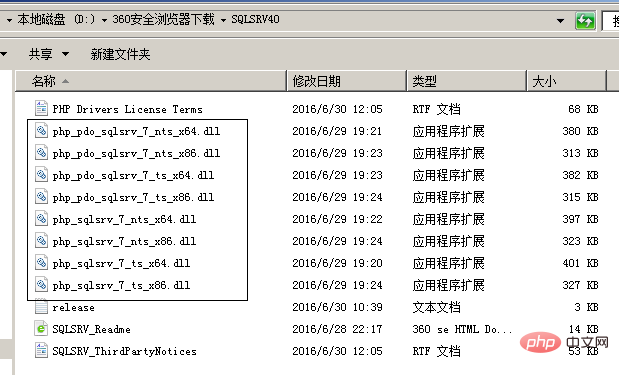

Step one, download the extension for 7.0.12 and configure the server
Extension download address for 7.0.x:
Microsoft Drivers for PHP for SQL Server https://www.microsoft.com/en-us/download/details.aspx?id=20098
Right-click the downloaded SQLSRV40.exe to unzip it Get the following dll files, these are PHP extensions

Installation configuration:
Download the first step, SQL Server PHP extension (Microsoft Drivers for PHP for SQL Server), there are multiple files in the connection, you only need to download SQLSRV40.EXE.
After decompression, select 32-bit or 64-bit extensions according to your PHP version, and pay attention to distinguish (Thread safe?) nts and ts.

Copy the files required for the extension to the PHP extension directory. (For example, what I use here is: php_pdo_sqlsrv_7_ts_x64.dll and php_sqlsrv_7_ts_x64.dll)
Modify php.ini and add the following two lines to enable the extension:
|
1 2 |
##extension=php_pdo_sqlsrv_7_nts_x86.dll |
## Recommended (free): PHP7Step 2:
Download ODBC Driver (database link driver) and installDownload ODBC Driver:
Microsoft® ODBC Driver 11 for SQL Server® - Windows (supports Sql Server® 2005) https://www.microsoft.com/zh-CN/download/details.aspx?id=36434
Microsoft® ODBC Driver 13 for SQL Server® - Windows Linux (supports the latest SQL Server® 2016) https://www.microsoft.com/zh-CN/download/details.aspx?id=50420
Here is the next step to install...
It is recommended to install the ODBC Driver , select the above address to download and install according to your needs.
If the above ODBC version is too high, then use this lower ODBC Driver to download https://files.cnblogs.com/files/wtcl/sqlserverodbc.zip
Now you can use phpinfo () to check whether the pdo_sqlsrv module is loaded successfully.
 Attention: If you connect to the database of an external server, pay attention to the firewall rules, otherwise there will be many problems
Attention: If you connect to the database of an external server, pay attention to the firewall rules, otherwise there will be many problems
More free Recommended:
The above is the detailed content of Introduction to adding Sqlserver extension to php7.0.X under win10. For more information, please follow other related articles on the PHP Chinese website!